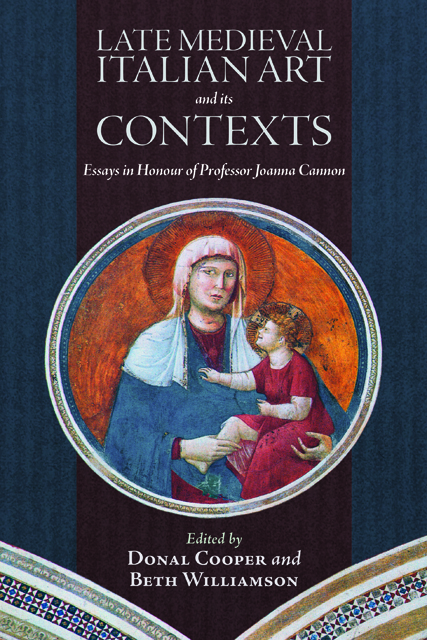Book contents
- Frontmatter
- Contents
- List of Illustrations
- List of Contributors
- Acknowledgements
- List of Abbreviations
- 1 Introduction: Circling Giotto
- 2 Holy Wood / ‘sacra tavola’: Saint Dominic and the Memory of Miracles in Bologna
- 3 The Sculpted Saint: A Statue of Saint Francis in Siena
- 4 Guccio di Mannaia and the Concept of a ‘Franciscan’ Chalice
- 5 ‘Speculum sine macula’: The Trittico di Santa Chiara in Trieste as an Object of Clarissan Devotion
- 6 The Siena Connection: A Franciscan Provincial Minister between Tuscany and Assisi at the Dawn of the Trecento
- 7 Simone Martini’s ‘Treaty with the House of Santa Fiora’ in Siena’s Palazzo Pubblico: Its Date and Significance
- 8 Crisis and Charity in Fourteenth-Century Florence: Ambrogio Lorenzetti’s Saint Nicholas Panels for San Procolo
- 9 Father of Light: Giotto and the Beatific Vision in the Baroncelli Chapel
- 10 Painter-Illuminator Workshops and the Church of San Giorgio a Ruballa: The Case of Bernardo Daddi and Pacino di Bonaguida
- 11 Patterns of Holiness: A Virgin Lactans in a Franciscan Context
- 12 A New Angle on Simone Martini’s Holy Family
- 13 Artistic Appropriation, Institutional Identity, and Civic Religion in Fourteenth-Century Siena: The Byzantine Treasury of the Hospital of Santa Maria della Scala
- 14 Visual Religious Education in Late Medieval Florence: Zanobi Perini, The Leggenda di Santo Tobia, and The Misericordia
- 15 Saints and Status in Late Medieval and Early Renaissance Florence
- Select Bibliography
- Publications by Joanna Cannon
- Index
- Tabula Gratulatoria
- Backmatter
13 - Artistic Appropriation, Institutional Identity, and Civic Religion in Fourteenth-Century Siena: The Byzantine Treasury of the Hospital of Santa Maria della Scala
Published online by Cambridge University Press: 20 December 2022
- Frontmatter
- Contents
- List of Illustrations
- List of Contributors
- Acknowledgements
- List of Abbreviations
- 1 Introduction: Circling Giotto
- 2 Holy Wood / ‘sacra tavola’: Saint Dominic and the Memory of Miracles in Bologna
- 3 The Sculpted Saint: A Statue of Saint Francis in Siena
- 4 Guccio di Mannaia and the Concept of a ‘Franciscan’ Chalice
- 5 ‘Speculum sine macula’: The Trittico di Santa Chiara in Trieste as an Object of Clarissan Devotion
- 6 The Siena Connection: A Franciscan Provincial Minister between Tuscany and Assisi at the Dawn of the Trecento
- 7 Simone Martini’s ‘Treaty with the House of Santa Fiora’ in Siena’s Palazzo Pubblico: Its Date and Significance
- 8 Crisis and Charity in Fourteenth-Century Florence: Ambrogio Lorenzetti’s Saint Nicholas Panels for San Procolo
- 9 Father of Light: Giotto and the Beatific Vision in the Baroncelli Chapel
- 10 Painter-Illuminator Workshops and the Church of San Giorgio a Ruballa: The Case of Bernardo Daddi and Pacino di Bonaguida
- 11 Patterns of Holiness: A Virgin Lactans in a Franciscan Context
- 12 A New Angle on Simone Martini’s Holy Family
- 13 Artistic Appropriation, Institutional Identity, and Civic Religion in Fourteenth-Century Siena: The Byzantine Treasury of the Hospital of Santa Maria della Scala
- 14 Visual Religious Education in Late Medieval Florence: Zanobi Perini, The Leggenda di Santo Tobia, and The Misericordia
- 15 Saints and Status in Late Medieval and Early Renaissance Florence
- Select Bibliography
- Publications by Joanna Cannon
- Index
- Tabula Gratulatoria
- Backmatter
Summary
On 27 September 1427, San Bernardino delivered one of his thundering sermons on the Piazza del Campo in Siena. As was customary with his preaching style, he dotted the sermon with local Sienese references, which, in this instance, included a colourful metaphor about the relative roles of the city cathedral and of its main charitable institution:
I remind you that this [hospital] is one of the eyes of your city, while the other eye is the episcopal see; they are very well placed next to each other. The right eye is the episcopal see, and the left is the hospital: the nose is the piazza that lies between them. You can see that it is elongated, like a nose. Oh, citizens, do take care of this hospital! … And if my mind does not err, both these institutions are dedicated to the Virgin Mary, and the city [itself] is called ‘of the Virgin’, therefore turn your minds to her glory.
The hospital that San Bernardino evokes in his sermon is Santa Maria della Scala, which, as he implicitly suggests through his eye metaphor, was one of the key civic institutions of medieval and Renaissance Siena. The hospital, as the passage indicates, occupied vast premises in front of the city cathedral and episcopal residence. Founded in the eleventh century, by Bernardino’s times the hospital was equipped with its own church, dedicated to the Virgin Annunciate, and prided itself on a set of precious relics and reliquaries of the Passion of Christ, of the Virgin Mary, and of saints. This holy collection was largely the result of a single acquisition made in Venice in 1359, when Santa Maria della Scala purchased an illustrious group of relics and reliquaries of Byzantine provenance from the merchant Pietro di Giunta Torrigiani. By 1427, when Bernardino delivered his sermon, the Byzantine relics had become the focus of a major and well-established public cult in Siena, contributing to the prestige of Santa Maria della Scala and to its civic status. But how was the integration of the Byzantine treasury into the highly specific Sienese civic cult achieved, what purposes did the Byzantine relics fulfil in Siena, and what correlations existed between their use in the Italian city-state and their original meaning in Byzantium?
- Type
- Chapter
- Information
- Late Medieval Italian Art and its ContextsEssays in Honour of Professor Joanna Cannon, pp. 249 - 270Publisher: Boydell & BrewerPrint publication year: 2022



